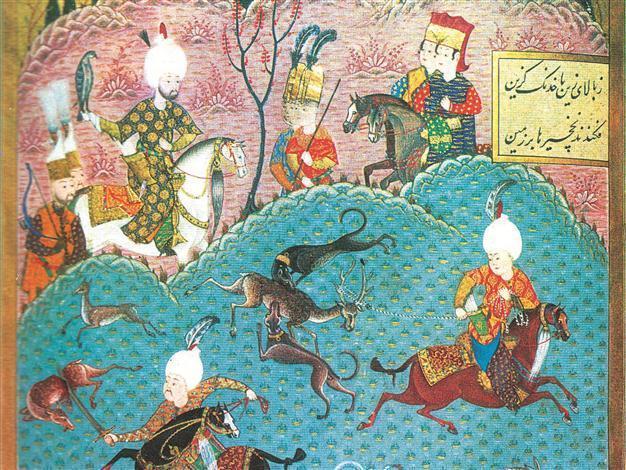Hunting, an imperial pastime in the Ottoman
Niki Gamm Hürriyet Daily News

All of the sultans up to the modern era hunted, even if only on palace grounds. Topkapı Palace was the center for the sultans’ hunting expeditions in Istanbul.
For those of you who are hunters, you’ll know that the season for birds and some mammals in Turkey ended last month, while hunting wild boar and jackal closes this weekend. Hunters these days aren’t after food to set on their tables usually; they derive satisfaction in the “chase” and the “kill.” And there’s nothing new in that.
An early story is told of how Şehzade Süleyman Paşa, the son of Orhan Gazi, died in a hunting accident in 1357. His horse stumbled and rolled over him as it fell. He had been a successful military commander and administrator and was the first Ottoman to lead an expeditionary force into Europe. He became something of a patron saint for later sultans, so we see that Sultan Ahmed I once detoured in order to pray at his mausoleum in Bolayır, near Çanakkale. Of course, he had hunted all the way there from Edirne and then on the way down to Istanbul, and no sooner had he settled in at Topkapı Palace than he moved across to his palace in Üsküdar, where he spent time hunting rabbits on the palace grounds. He moved to other palaces along the Bosphorus to continue hunting, presumably when his prey ran out.
Necessity to luxuryWhen hunting turned from being a necessity to being a luxury is unknown. Royalty among the ancient Egyptians and other civilizations in the Middle East hunted and have left us carvings, illustrations and texts. Romans, Byzantines and Islamic rulers also took up the practice, so it’s no wonder that the Ottomans did so too.
There seems to have been two types of hunting. One type, generally referred to as a garden park, was contained within fences or walls and the animals were stocked and looked after in terms of food and water. It is known that there was one in the Middle Byzantine era, outside the city walls where the Blachernae Palace was located. But when the emperor really wanted to hunt, he would go further afield. Emperor John II Comnenos was killed while boar hunting in the Taurus Mountains; he scratched himself with a poisoned arrow intended for the boar. Emperor Basil I died from complications after a deer’s antler caught him by the belt and dragged him for miles. The Byzantine emperors seem to have been particularly careless, for we don’t hear of any Ottoman sultan dying as a result of hunting.
As far as can be determined, all of the sultans up to the modern era hunted, even if only on palace grounds. Topkapı Palace was the center for the sultans’ hunting expeditions in the Istanbul area, although they did use some of the other palaces in the vicinity. It was at Topkapı that the horses which a sultan used for hunting would be kept, as well as his birds and dogs. A chief falconer would be in charge of all the falconers at the beginning, but in the 16th century, hawking was at its height so three more falconers were appointed. The birds they looked after included peregrines, lanners and sparrow-hawks. The use of the birds fell out of favor in the second half of the 16th century, during or after the reign of Sultan Selim II (1566-1574). These birds were raised and trained by the falconers.
In addition to the birds, dogs were used and valued so highly that they were known to wear silver collars. The Janissaries were charged with looking after the training and the welfare of these dogs, which were greyhounds and mastiffs. There don’t seem to have been any hunts at Topkapı itself – miniatures show deer roaming around the palace grounds. And cranes were known to have been kept there. In other palaces around the city it seems that rabbits were hunted the most. Several of the hunting lodges in Istanbul still exist today from the middle of the 19th century – Küçüksu, Maslak and Ihlamur Kasrı, for example – but they were used for summer residences as well.
To really hunt, the sultan had to go outside the city, and large hunting establishments and preserves were established throughout the Empire. Some were so large that thousands would be employed to see to the upkeep of the lodges and the hunting grounds. The sultans particularly liked the area around Edirne and Sultan Murat I even built an extensive hunting lodge at Çömlek, which later sultans used. This place was so frequently used that some sultans apparently even conducted affairs of state there, even receiving diplomatic delegations.
Duty rather than sportHarvard University Professor Gülru Necipoğlu has noted that while Sultan Süleyman I hunted extensively, his successors seemed to treat hunting more as a duty expected of a sultan than addiction to the sport. Still, according to records kept for such hunts, there was one instance when Sultan Ahmed I bagged 18 deer, 150 hares, 40 foxes and several wolves and on another occasion, 12 deer, 127 hares, 33 foxes and one wolf.
But then Ahmed’s hunting may have been due to his wish to be compared to his great grandfather, Süleyman I. He kept a hunting establishment at Topkapı that numbered around 600. k HDN
